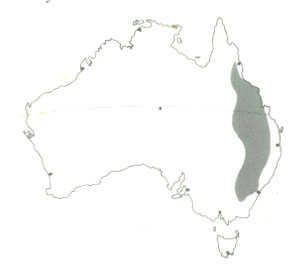![]()
 |
 |
DISTRIBUTION: Confined to savanna country in eastern Australia, south ot Canberra; favours grass, reeds and bushes along margins of creeks and rivers. Locally and seasonally common in southern parts. Nomadic in drier regions, sedentary near water. |
A pair of Plum-headed finches. The male is on the left. |
Distribution Map |
|
IDENTIFICATION. LENGTH = 110 mm MALE: Upper parts olive-brown; rump and upper tail-coverts olive-brown with white bars; tail black; wing olive-brown with white spots. Top of head, forehead and chin claret-red; lores black; ear-coverts white streaked brown; cheeks white. Underparts white with thin olive-brown bars. Eye dark brown; bill black; legs pink-brown. FEMALE: Duller than male and no claret coloured chin; white line above eye. IMMATURES: No claret-red head markings; underparts white with almost no bars.
|
NESTING. Breeds September-January in south; August-March in north. Nest round, laterally compressed chamber of green grass, sometimes lined wth feathers; measures 110 mm long, 130 mm high and 75 mm wide. Placed in tall grass stems where some blades built into nest walls. Also found in thick bushes. Eggs: five or six; pure white; 17 X 12 mm.
|
|
FORMS.
|
|
AVIARY BREEDING. NESTING TYPES: I have found that these birds will nest almost anywhere although they will usually prefer a nest box including parrot nest boxes rather than build a nest of their own. I have seen these birds build nests in tea tree branches and planted trees but very rarely. Best results have been from boxes 150 mm square X 125 mm high with a 40 mm access hole in the front and a small landing platform just below the entrance. (See the Plans page for more information) FEEDING: A general finch mix is ideal for this bird. Birds will also readily take seeding grasses and live food. However I have had seen these birds breed successfully with just a mixed seed diet. Egg and biscuit will also be taken readily. OTHER FEEDS: Cuttlebone and shell grit should be supplied at all times. SPECIAL REQUIREMENTS: There are no special requirements for this species. However care should be taken not to house this species with the Masked Finch or the Long-tailed Finch or any of the subspecies.
|
| AVIARY SPECIFICATIONS. | WIRE MESH: 1/4 x 1/4 or 6 mm x 6 mm | Also known as mouse wire |
| LENGTH: 11ft 6in or 3575 mm | WIDTH:6ft or 1800 mm | HEIGHT: 8ft or 2400 mm |
| SHED: Half the aviary should be enclosed.
These are recommendations only and individual breeders may have different dimensions and specifications.
|
FLOOR: I have found a dirt floor preferable. |
OTHER: |
|
BREEDER SUBMISSIONS. |
|
| From |
![]()
Author
P Campbell
Copyright © 2002 P. Campbell. All rights reserved.
Revised: April 23, 2002
.